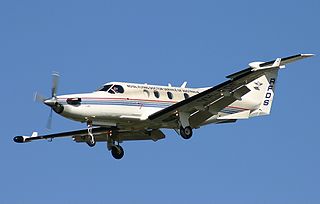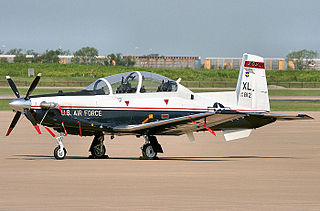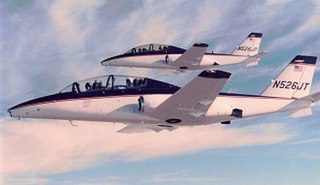Related Research Articles

The Learjet 60 is a mid-size cabin, medium-range business jet aircraft manufactured by Bombardier Aerospace in Wichita, Kansas. Powered by two Pratt & Whitney Canada PW305A engines, it has a range of 2,405 nautical miles (4,454 km) with NBAA 100 nmi (190 km) reserves, ISA. In July 2012 Bombardier Aerospace announced a temporary "production pause" of the latest variant Learjet 60XR to begin in the fourth quarter of 2012.

The Pilatus PC-12 is a single-engine turboprop passenger and cargo aircraft manufactured by Pilatus Aircraft of Stans, Switzerland, since 1991. The main market for the aircraft is corporate transport and regional airliner operators. The PC-12 is the best-selling pressurized single-engine turbine-powered aircraft in the world and has been for several consecutive years, with 1,700 deliveries as of October 2019.

The Pilatus PC-6 Porter is a single-engined STOL utility aircraft designed by Pilatus Aircraft of Switzerland. First flown in 1959, the PC-6 continues in production at Pilatus Flugzeugwerke in Stans, Switzerland. It has been built in both piston engine- and turboprop-powered versions and was produced under licence for a time by Fairchild Hiller in the United States. After around 600 deliveries in six decades, Pilatus produced the last one in early 2019.

The Pilatus PC-9 is a single-engine, low-wing tandem-seat turboprop training aircraft manufactured by Pilatus Aircraft of Switzerland. Designed as a more powerful evolution of the Pilatus PC-7, the PC-9's first flight was made in May 1984 after which certification was achieved in September 1985. After this, the first production orders for the type were received from the Royal Saudi Air Force, with deliveries commencing in 1985. Since then, more than 250 airframes have been produced across five different variants and the type is employed by a number of military and civilian operators around the world, including the Swiss Air Force, the Croatian Air Force, and the Royal Thai Air Force.

The Joint Primary Aircraft Training System (JPATS) was an aircraft procurement program of the United States in the 1990s by the United States Air Force and United States Navy, a merger of 1980s era training aircraft programs. The winner was declared in 1995 and entered service a few years later as the Beechcraft T-6 Texan II. The program was partly a result of the cancelled Fairchild T-46 of the 1980s.

The North American Sabreliner, later sold as the Rockwell Sabreliner, is an American mid-sized business jet developed by North American Aviation. It was offered to the United States Air Force (USAF) in response to its Utility Trainer Experimental (UTX) program. It was named "Sabreliner" due to the similarity of the wing and tail to North American's F-86 Sabre jet fighter. Military variants, designated T-39 Sabreliner, were used by the USAF, United States Navy (USN), and United States Marine Corps (USMC) after the USAF placed an initial order in 1959. The Sabreliner was also developed into a commercial variant.

The PZL 130 Orlik is a Polish turboprop, single engine, two seat trainer aircraft.

The Hawker 400 is a light business jet. Initially designed and built by Mitsubishi, it has been further developed and updated by the Beech Aircraft Company, now part of Textron Aviation.

The Lockheed XV-4 Hummingbird was a U.S. Army project to demonstrate the feasibility of using VTOL for a surveillance aircraft carrying target-acquisition and sensory equipment. It was designed and built by the Lockheed Corporation in the 1960s, one of many attempts to produce a V/STOL vertical take off/landing jet. Both prototype aircraft were destroyed in accidents.

The RFB Fantrainer is a two-seat flight training aircraft which uses a mid-mounted ducted fan propulsion system. Developed and manufactured by German aircraft company Rhein-Flugzeugbau GmbH (RFB), it has been used by the Luftwaffe and Royal Thai Air Force.

The Gulfstream American Hustler was a 1970s American mixed-power executive/utility aircraft designed by American Jet Industries. The aircraft had a nose-mounted turboprop and a tail-mounted turbofan.
The AAC Wamira was a turboprop military trainer aircraft, designed for the Royal Australian Air Force (RAAF) by the Australian Aircraft Consortium (AAC). The project was cancelled shortly before the first prototype was completed.

The Cessna Citation V is a business jet built by Cessna, stretched from the Citation II. A prototype flew in August 1987, it was certified on December 9, 1988 and delivered from April 1987, 774 were delivered until 2011. The upgraded Citation Ultra was announced in September 1993, the Citation Encore upgraded with PW535 turbofans was announced in 1998, before the improved Encore+. Its US Military designation is UC-35.

The Gulfstream American Peregrine 600 was a military trainer aircraft developed in the United States in the early 1980s but which did not progress further than prototype stage. Developed from the company's Hustler business aircraft, the Peregrine shared the same wings, empennage and rear fuselage, but had a new forward fuselage with side-by-side seating for the pilot and instructor. The aircraft was developed as a contender in the United States Air Force's Next Generation Trainer program, but was ultimately passed over in favor of the Fairchild T-46. Attempts to market it to the air forces of Australia, New Zealand, Japan, and China also proved unsuccessful, and the project was canceled in 1985. The wing and rear fuselage design was incorporated in the Gulfstream Aerospace Peregrine business aircraft.

The Cessna 526 CitationJet was a twinjet trainer candidate for the United States Joint Primary Aircraft Training System proposed by Cessna. It was a twin-engined, tandem seat aircraft, based on the Cessna CitationJet executive aircraft. However, it was unsuccessful, with only two prototypes built.
The Atlas ACE is a South African turboprop trainer, that was designed by the Atlas Aircraft Corporation as a contender to replace the North American Harvard in service with the South African Air Force. The aircraft was not selected and only two examples were completed.

The UTVA Kobac is a prototype light military trainer aircraft in development by UTVA. It is a single-engine, low-wing tandem-seat turboprop training aircraft with a metal airframe. The aircraft will be capable of higher basic training functions including aerobatics, instrument, tactical flying and it provides an easy transition to jet trainer at higher training levels. And also will be capable of performing close air support, counter insurgency (COIN), and reconnaissance missions. Kobac is Serbian for sparrowhawk.
The Sport Jet II was an American amateur-built aircraft that was under development by Sport-Jet, Limited. The Sport Jet was designed by Robert Bornhofen who licensed the intellectual property to Excel Jet. The aircraft was intended to be supplied as a kit for amateur construction. The first Sport Jet built crashed on takeoff after logging 23.8 hours of flight time.

The Pilatus PC-24 is a light business jet produced by Pilatus Aircraft of Switzerland. Following the PC-12 single turboprop success, work on the jet started in 2007 for greater range and speed, keeping the rugged airfield capability. The aircraft was introduced on 21 May 2013 and rolled out on 1 August 2014, with the maiden flight on 11 May 2015. The PC-24 received EASA and FAA type certification on 7 December 2017 and the first customer delivery was on 7 February 2018. Powered by two Williams FJ44 turbofans, it competes with the Embraer Phenom 300 and the Cessna Citation CJ4.
The Scaled Composites 401 is an American experimental aircraft, designed and produced by Scaled Composites of Mojave Spaceport, Mojave, California, introduced in 2017. The two examples built were constructed for an unnamed customer to demonstrate "advanced, low-cost manufacturing techniques" for the production of research aircraft for both industry and government.
References
- Notes
- 1 2 3 4 Taylor 1996, page 155
- ↑ "Third Ranger 2000 is flown". Flight International: 13. 29 June 1994.
- ↑ Tulsa Air and Space Museum – Exhibits Archived 22 May 2009 at the Wayback Machine
- Bibliography
- Taylor, Michael J. H. (1996). Brassey's World Aircraft & Systems Directory . London, England: Brassey's. ISBN 1-85753-198-1.